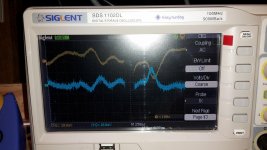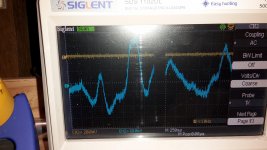On several tube mic preamp PSUs I have built in that last couple of years I have noticed the same thing. A very low frequency low level variation in the output voltage. My latest PSU uses a series of five 100uF caps with 1K resistors in between and it still exhibits this problem. The 'noise' seems to be below 1Hz in frequency, fairly random and peaks typically between +- 10mV with occasional excursions to +-20 to 30mV.
Because the noise is so small, about the only place you can see it is on the smoothed output with a scope set to ac input. I suspect this noise is mains borne but I don't know how to see such small low frequency signals on the mains itself. Any ideas what it is, how to look at it on the mains and how to get rid of it?
Cheers
Ian
Because the noise is so small, about the only place you can see it is on the smoothed output with a scope set to ac input. I suspect this noise is mains borne but I don't know how to see such small low frequency signals on the mains itself. Any ideas what it is, how to look at it on the mains and how to get rid of it?
Cheers
Ian
I have seen this same phenomena in several of my designs using unregulated supplies and it definitely appears to be caused by small long term (low frequency) variations in the mains voltage. I have also done experiments on the bench where I looked at a rectified and well filtered unregulated dc supply loaded into a resistor bank and I can see it there as well.
Some of my tube based regulators have enough loop gain to remove most of this variation, and the maida solid state regulators definitely do.
Practically speaking there isn't much you can do about this short of using voltage regulation on your supplies or designing power supplies with huge time constants (probably not a good idea).
This becomes a problem in phono stages and microphone amplifiers where there is lots of gain and where minute LF shifts in the first stage plate voltage get amplified by successive stages.
I've also noted that in these applications minute variations in filament voltage can also amplify the effect so regulating filament supplies may help here..
Choosing rc time constants carefully can help a lot wrt to this issue, but won't eliminate it totally, and carried to an extreme you can also loose useful bass response..
One of the problems this can create in tape recording applications is that it might, depending on recording amplifier design, result in saturation of the recording head or tape in extreme cases. Pretty unlikely but not impossible.
Some of my tube based regulators have enough loop gain to remove most of this variation, and the maida solid state regulators definitely do.
Practically speaking there isn't much you can do about this short of using voltage regulation on your supplies or designing power supplies with huge time constants (probably not a good idea).
This becomes a problem in phono stages and microphone amplifiers where there is lots of gain and where minute LF shifts in the first stage plate voltage get amplified by successive stages.
I've also noted that in these applications minute variations in filament voltage can also amplify the effect so regulating filament supplies may help here..
Choosing rc time constants carefully can help a lot wrt to this issue, but won't eliminate it totally, and carried to an extreme you can also loose useful bass response..
One of the problems this can create in tape recording applications is that it might, depending on recording amplifier design, result in saturation of the recording head or tape in extreme cases. Pretty unlikely but not impossible.
coloradosound said:Your description sounds more like popcorn noise.
I've read it being more common in older solid state OP amps
but haven't ever heard anybody say anything about
popcorn noise from tubes. Could also be microphonic tubes?
Popcorn noise by definition sounds a lot like popcorn, it is random bursts of noise generated typically by early operational amplifiers - it was generally caused by a fabrication process defect, and is quite uncommon in modern op-amps.
The problem described which I have also encountered is generally inaudible but may result in woofer "breathing" in systems with electrical response down to near dc. Usually microphone pre-amplifiers and phono stages or tape head amplifiers are most susceptible to this problem because of the large amounts of loop gain available.
I've seen this too on the mains if it's non-sinusoidal and fairly random. Especially when the gear is sharing a power strip with a temperature controlled soldering iron(because it toggles on and off). Or when the washer/dryer, dish washing machine, ect.. is running.
If it's a continuous sub-sonic sine wave that presents itself at the output. It's possible your getting positive feedback between stages on the B+. This occurs in some circuits when the coupling networks f3 is close-to or lower-than the decoupling networks. Just for re-assurance, I generally design so that subsonic B+ feedback is always negative if it were to occur. That's for un-regulated, in regulated supplies it's not a problem.
If it's a continuous sub-sonic sine wave that presents itself at the output. It's possible your getting positive feedback between stages on the B+. This occurs in some circuits when the coupling networks f3 is close-to or lower-than the decoupling networks. Just for re-assurance, I generally design so that subsonic B+ feedback is always negative if it were to occur. That's for un-regulated, in regulated supplies it's not a problem.
coloradosound said:Your description sounds more like popcorn noise.
I've read it being more common in older solid state OP amps
but haven't ever heard anybody say anything about
popcorn noise from tubes. Could also be microphonic tubes?
That was my first thought, that or some weird form of 1/f noise. However, I get exactly the same without any tubes connected, just the PSU on its own with a dummy resistor load so it is definitely NOT the tubs this time!
Cheers
Ian
kevinkr said:I have seen this same phenomena in several of my designs using unregulated supplies and it definitely appears to be caused by small long term (low frequency) variations in the mains voltage. I have also done experiments on the bench where I looked at a rectified and well filtered unregulated dc supply loaded into a resistor bank and I can see it there as well.
That was my most recent test - just the PSU with a dummy resistive load - no tubes - same result. Good to hear someone else has come across the same thing.
Some of my tube based regulators have enough loop gain to remove most of this variation, and the maida solid state regulators definitely do.
Practically speaking there isn't much you can do about this short of using voltage regulation on your supplies or designing power supplies with huge time constants (probably not a good idea).
A regulated supply was my first thought - good to hear it can do the trick. I'll check out the maida regulators.
This becomes a problem in phono stages and microphone amplifiers where there is lots of gain and where minute LF shifts in the first stage plate voltage get amplified by successive stages.
I've also noted that in these applications minute variations in filament voltage can also amplify the effect so regulating filament supplies may help here..
Interesting - at present the effect seems to be the same on a dummy load as with tubes with unregulated ac filaments. I'll keep an eye out for that.
Cheers
Ian
On several tube mic preamp PSUs I have built in that last couple of years I have noticed the same thing. A very low frequency low level variation in the output voltage. My latest PSU uses a series of five 100uF caps with 1K resistors in between and it still exhibits this problem. The 'noise' seems to be below 1Hz in frequency, fairly random and peaks typically between +- 10mV with occasional excursions to +-20 to 30mV.
Because the noise is so small, about the only place you can see it is on the smoothed output with a scope set to ac input. I suspect this noise is mains borne but I don't know how to see such small low frequency signals on the mains itself. Any ideas what it is, how to look at it on the mains and how to get rid of it?
Is there really a 'problem' requiring a solution for starters?
Perhaps putting some numbers on the disturbances would help, but it sounds like you may need a modern 6-digit multimeter with stats analysis tools to quantify.
Then you have to show yourself that some equivalent fixed frequency signal of similar amplitude would actually have some gain through your signal chain at that frequency, or cause some intermodulation effect.
And then you'd have to rationalise that there was some demerit to using the output signal (do you record the output with a response to <<1Hz, or is there a speaker where the disturbance would cause some intermodulation or constrain cone excursion).
This is what i have been seeing as well. Did anyone come up with a solution to this.
In my case i have shunt regulated HT and fillament regulation
We do have a very large mining concentrator nearby that uses imense amounts of energy.
1. Better PSRR in the amplification chain
2. Voltage stabilized PS
With green energy sources connected to the grid the problem is worse and worse.
Dang - missed looking at the dates!
That said, the issue is still somewhat similar. Although you may well have much more onerous deviations of mains voltage, and at faster rates of change, than what Ian was observing a decade ago.
Maybe a flicker and fluctuation meter reading would be more appropriate for you to gauge whether the utility needs to do something about the nearby mining plant.
That said, the issue is still somewhat similar. Although you may well have much more onerous deviations of mains voltage, and at faster rates of change, than what Ian was observing a decade ago.
Maybe a flicker and fluctuation meter reading would be more appropriate for you to gauge whether the utility needs to do something about the nearby mining plant.
Pictures from other thread.
I dont think I am going to be able to do anything about the quality of power here. The mine here uses 2% of the states power. So in a town of 40000 people that would be mega mega..
I dont think I am going to be able to do anything about the quality of power here. The mine here uses 2% of the states power. So in a town of 40000 people that would be mega mega..
Attachments
Wavebourne.
I don't know what i can do to improve PSSR.
My preamp has 4 kandk shunt and ccs regs. 2 per channel 1 per stage. Plus i have 1 power supply per channel. (However only using one channel for now.) Plus i have 4 fillament regulators.
I have a little voltage headroom for some sort of pre reg.
I don't know what i can do to improve PSSR.
My preamp has 4 kandk shunt and ccs regs. 2 per channel 1 per stage. Plus i have 1 power supply per channel. (However only using one channel for now.) Plus i have 4 fillament regulators.
I have a little voltage headroom for some sort of pre reg.
- Status
- This old topic is closed. If you want to reopen this topic, contact a moderator using the "Report Post" button.
- Home
- Amplifiers
- Tubes / Valves
- Low Frequency Mains Noise

